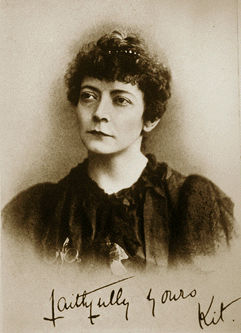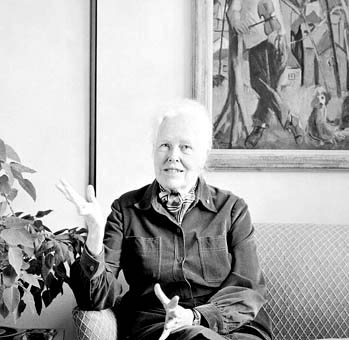Kathleen Blake “Kit” Coleman (née Catherine Ferguson), journalist, war correspondent (born 20 February 1856 in Castleblakeney, Ireland; died 16 May 1915 in Hamilton, Ontario). Kathleen Coleman was the first female journalist in Canada to oversee her own section of a Canadian newspaper, writing and editing the women’s section of the Toronto Daily Mail. She was also North America’s first accredited female war correspondent, the first president of the Canadian Women’s Press Club and the first Canadian with a syndicated column. The Royal Canadian Mint issued a commemorative silver dollar in her honour in 2023.

Early Life and Education
Kathleen Coleman was born Catherine Ferguson in Ireland in 1856. She later changed her name to Kathleen and added the name Blake to imply a connection to a prominent Galway family. The surname she is best known for, Coleman, comes from her third husband, Theobald Coleman.
Coleman grew up in the countryside near Galway, Ireland. From her father she developed a love of nature and books, and her mother taught her to play musical instruments. Her maternal uncle was Thomas Burke, a priest and prominent liberal speaker who influenced Coleman’s social tolerance. She was educated at Loretto Abbey in Rathfarnham, near Dublin, and a finishing school in Belgium.
Marriages and Emigration to Canada
While Coleman’s father was a landlord with modest holdings, the family had little money. Her parents arranged her marriage to Thomas Willis, an elderly, wealthy country squire, to provide her with financial stability. It was an unhappy marriage, and she was left penniless after his death. Their one child, a daughter, died at age two. Having been well educated in languages, music and classics, Coleman worked as a governess in London before emigrating to Canada in 1884.
Settling in Toronto, Coleman worked as a secretary and married her boss, Edward Watkins. They moved to Winnipeg after their marriage, where Watkins worked as a salesman and Coleman taught music and French. The couple struggled financially, and Watkins was an alcoholic and philanderer. He may still have had a wife in England as well. After returning to Toronto and separating from Watkins, Coleman turned to journalism to support her two children.
Journalism Career
Kathleen Coleman’s journalism career began by selling short stories to Saturday Night, a Toronto-based magazine. Her writing caught the attention of the owner of the Toronto Daily Mail, who hired her as editor of the newspaper’s new women’s pages. In the late 19th century, newspapers began including women’s sections to increase female readership and circulation. Coleman was the first woman in Canada to manage a section of a newspaper. While Coleman had no training in journalism before starting at the paper, she became a pioneering female journalist who paved the way for other women in the industry.
Coleman’s column, “Woman’s Kingdom,” began as a half page before expanding into an entire seven-column page. The page was so outspoken that it attracted a wide following, including Prime Minister Wilfrid Laurier. Coleman tackled anything that interested her, including political commentary, theatre criticism, fashion notes and recipes. One of her most popular features was "Advice to the Lovelorn." She was concerned with social justice issues and the welfare of people in poverty and also reported on those issues in other cities. In 1897, she travelled to England to cover Queen Victoria’s Diamond Jubilee.
Coleman wrote her pieces from her boarding house and went into the newspaper office once a week to supervise the setting of her column. Coleman was near-sighted and had to write with the pen close to her face, resulting in almost illegible handwriting. She wrote under the pen name “Kit.”
Spanish-American War Correspondent
Kathleen Coleman was one of the first women in the world to become an accredited war correspondent. In April 1898, war broke out between the United States and Spain, primarily over the issue of Cuban independence.
Coleman lobbied the United States Secretary of War to become an accredited war correspondent, writing for the Mail and Empire. Male journalists and military authorities tried to block Coleman’s journey to the front in Cuba. Unlike male war correspondents, Coleman was not allowed to join military units. Two ships deliberately left her behind, and she was stuck in Florida for the first three months of the war. She finally reached Cuba on a naval supply ship in late July.
By the time Coleman arrived in Cuba, the bulk of the fighting was over. She traveled around battle sites on horseback, reporting on the aftermath of the war and its toll on soldiers and civilians. Fluent in Spanish, Coleman was able to report on both sides of the story. Coleman’s war correspondence brought her significant professional attention and was the pinnacle of her career.
Coleman returned to America from Cuba aboard the transport ship Comal, which carried wounded American soldiers. The ship was ill equipped, with only one doctor and not enough food, water and medical supplies. Coleman and other journalists aboard donated their personal medical supplies to help the soldiers. Coleman declined an offer to conduct a lecture tour through America about her experience in Cuba because she felt that the war had been mismanaged.
Canadian Women’s Press Club
At the start of the 20th century, around 50 women were working as journalists in Canada. In 1904, Coleman and 15 other Canadian women journalists received press passes to attend the St. Louis World’s Fair. The press trip was a rare opportunity for the journalists to convene, since they were spread across the country and often isolated as the only women at their publications. On their train journey (reports differ on whether it was to or from St. Louis), the women formed the Canadian Women’s Press Club to provide a professional network for women journalists. Coleman was elected as the club’s first president.
I think we press women ought to get up a club or association of some kind and try to meet once a year. I don’t suppose we would claw each other too awfully and a little fun might be got out of our speech-making. Why should Canadian men journalists have all the trips and banquets?
(Kathleen Coleman, Mail and Empire, May 1904).
Later Life and Career
Kathleen Coleman married her third husband, Theobald Coleman, on her return from the Spanish-American War. As a doctor, Theobald didn’t like to charge his lower-income patients, and Coleman’s journalism salary was necessary to support the family. The couple lived in Copper Cliff, near Sudbury, for a few years while Theobald worked as a doctor for the Canadian Copy Company. They arrived in the town during a smallpox outbreak, and Coleman assisted as an emergency nurse. She used her column to advocate for vaccinations and successfully lobby the government to establish quarantine houses. In Copper Cliff, Coleman was isolated, and she suffered from depression and a series of illnesses and accidents. In 1904, the Colemans moved to Hamilton.
After a series of disputes with management over pay and editorial control, Coleman left the Mail and Empire (formerly the Toronto Daily Mail) in early 1911. In her later career with the paper, Coleman earned between $25–35 per week, whereas her male counterparts earned between $35–50 per week. She started her own syndicated column, “Kit’s Column,” which covered a range of topics. She was the first syndicated columnist in Canada. Her column was printed in dozens of newspapers across Canada, although she did not allow her former employer to run it. Charging $5 for each paper that ran her column, Coleman earned more than she had made as an employee at the Mail and Empire. She continued “Kit’s Column” until her death from pneumonia in 1915.
Honours
Kathleen Coleman paved the way for women in the press in Canada. She was inducted into the Canadian News Hall of Fame and has been designated a National Historic Person. In July 2023, the Royal Canadian Mint issued a commemorative silver dollar in honour of this pioneering journalist. Designed by artist Pandora Young, it was issued as part of the 2023 Fine Silver Proof Set.

 Share on Facebook
Share on Facebook Share on X
Share on X Share by Email
Share by Email Share on Google Classroom
Share on Google Classroom






